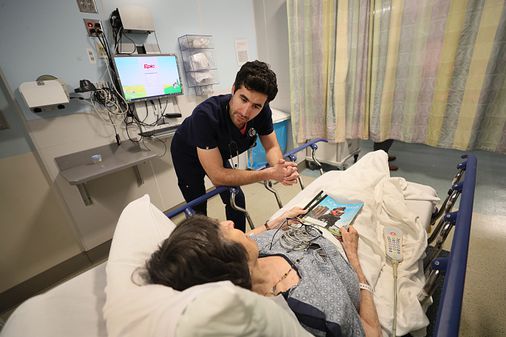The young man, who ferried equipment up and down the mountain for climbers, was suffering acute high-altitude sickness, Apisa concluded, “drowning in his own blood.” He administered oxygen and steroids to reduce swelling in the man’s brain and crossed his fingers.
The clinic, a plywood hut powered by solar panels and car batteries, was miles from help. It had no imaging equipment to check for head injuries, no lab to help find clues of what might be going wrong. The doctor evaluating him, Luke Apisa, a physician from Massachusetts General Hospital, instead had to rely on a handheld device that showed fluid in his lungs and what he could observe.
The patient arrived at the makeshift clinic near a Mount Everest base camp strapped to the back of a fellow porter. He was unconscious, on the verge of death.
Advertisement
The diagnosis was right. The man lived. But Apisa’s work in this harsh environment of thin air and extreme cold was meant as training for conditions even more austere — outer space.
His recent three-month rotation at Everest was part of a new Space Medicine Fellowship by Mass. General and Baylor College of Medicine in Houston, one of a handful of new and planned programs across the country that are anticipating a need for medical care in a coming boom of space travel and prolonged missions to the moon and beyond. Hoping to help prepare physicians for the unparalleled challenges they would face on such missions, the MGH fellowship sends them to some of the most harsh and remote places on Earth.
“This is one of the best analogs we have for what space medicine is like,” said Apisa, 31, who is an emergency room physician with a specialty in wilderness medicine.
The makeshift clinic where Dr. Luke Apisa worked in the village of Рhеriсhе in Nepal, near Mount Everest base camp. Dr. Luke Apisa
Luke Apisa assists a patient in the clinic in the Nepalese village of Pheriche. Luke Apisa
No longer the grist of science fiction, life in space is expected to soon become a reality for growing numbers of astronauts and space tourists. NASA is planning a long-term base on the moon, in addition to a Gateway station in lunar orbit from which scientists will work and eventually launch missions into deep space, including to Mars. And private companies are racing to build out commercial programs. Elon Musk’s SpaceX is already advertising for reservations aboard its Starship mission to the Moon’s orbit, saying it will eventually “carry up to 100 people on long-duration, interplanetary flights.”
Advertisement
There will be a need for doctors trained to deliver complex medical care in those conditions, emergency medicine specialists at Mass General and Baylor College said.
For decades, NASA’s paradigm has focused on preventative medicine — essentially finding the brightest people on Earth who are also in the most pristine of health to reduce as much as possible the risk of serious medical emergencies in space. For medical care on flights, at least one astronaut with 40 hours of paramedic-level training is aboard, and in the event of a serious medical emergency, there is a chief flight surgeon in Mission Control who could talk a crew through care from the ground.
But that arrangement is likely to change if long-distance missions become a reality and space travel is routinely made available to a wider range of people, experts said. Physicians will need to accompany missions to space and not only have specialized knowledge of the possible medical problems space could present but be able to make sound decisions with limited diagnostic tools.
Advertisement
“If you are pushing off earth’s surface, you have to be thoughtful of what you can take,” said Dr. N. Stuart Harris, an emergency medicine physician at Mass General who chairs its SPEAR MED division which includes space medicine and wilderness medicine fellowships, as well as climate change programs. He is co-directing the new space fellowship.
“There are pressure considerations, lack of oxygen considerations, you have radiation concerns, and it’s a long way home, so you need to think about what you would do,” Harris said.
That is where the more adventurous elements of MGH’s two-year space medicine fellowship come in. The program includes training in rescue medicine, a rotation in NASA’s medical research branch, as well as a rotation at SpaceX to learn about commercial space flight. Critical is the kind of rotation Apisa just finished, as lead medical officer on an expedition to a remote location such as Alaska or the Himalayas.
As in space, there are significant time and distance constraints with caring for patients in the clinic at Everest. A helicopter can ferry acutely ill patients down the mountain in about an hour, but because cloud cover is so often an issue it usually means flights are unable to make it to the remote clinic for at least a day. That delay, along with the limited access to medical and diagnostic machines, makes for ideal space training conditions.
Advertisement
“It’s wonderful to work in a big tertiary care center like Mass General where you have access to everything, and you can get any test in the world you want,” Apisa said. “Doing work in an austere environment, it hones your skills. It forces you to rely on everything you learned in medical school.”
Inside the clinic, Thaneshwar Bhandari, left, a Nepali paramedic, and Dr. Nishant Joshi, right, work with Dr. Apisa to care for patients. Dr. Luke Apisa
The fellows will also learn about the effects of space on the human body which can create significant challenges for even the healthiest people.
For example, in zero and low gravity, air doesn’t diffuse the way it does on earth, so if it is not kept moving in a space station or capsule, astronauts could breathe in their own carbon dioxide and potentially suffocate, Apisa said. And doctors need to be aware that without gravity, urine, blood, and other substances can float unconstrained, presenting substantial infection risks.
Lack of gravity also has peculiar effects on the human body.
“Astronauts seem to accumulate too much water in the brain, and we don’t fully understand why this occurs … and how we can prevent this,” said Lonnie Petersen, an assistant professor of aeronautics and astronautics at the Massachusetts Institute of Technology.
The condition, known as Spaceflight-Associated Neuro-Ocular Syndrome, or SANS, has led to lasting vision problems, with some astronauts reporting they are not able to see as well up close after a flight.
“It’s a complex syndrome, and we don’t fully understand why it doesn’t fully resolve as you reintroduce gravity,” Petersen said.
Researchers are concerned that as more people spend longer times in space, SANS will become more common.
Advertisement
There’s also concern about the long-term effect of weightlessness on muscle and bone density. The space station is equipped with exercise devices that allow astronauts to work against springs and pulleys to maintain fitness.
“As we have more commercial space flight, we will have a different composition of crew members, we will see more preexisting conditions, the age range will expand, and obviously the way we do medicine is evolving,” Petersen said.
The Space Medicine Fellowship will train doctors to think like engineers so they can help design space operations for long-term flight that will focus on protecting human health, said Dr. Erik Antonsen, associate professor of space medicine at Baylor College of Medicine, and a co-director of the fellowship. Antonsen formerly worked at NASA’s Johnson Space Center assessing health risks for astronauts.
“We are trying to find the right balance between human physiology and engineering,” he said.
One immediate concern is designing a safe system for frequent space walks on the moon. On the International Space Station, each astronaut typically performs no more than five walks during a six-month stint. Each walk requires several hours of prep time in 100 percent oxygen to slowly acclimate to the extremely low air pressure outside in order to avoid dangerous bubbles forming in their joints, Antonsen said.
But on the moon, NASA is planning daily space walks. A safe process with shorter prep times will be necessary, he said.
Dr. Jonathan Clark, who will be teaching the new space fellows, puts it this way: “The human body is incredibly resilient and tolerant but also at the same time can be exceptionally vulnerable.”
Clark, a clinical professor of neurology and space medicine at Baylor College of Medicine, served as a Naval flight surgeon and headed several Naval research facilities. Health and safety are deeply personal for him; his wife Laurel Clark, a NASA astronaut, died along with her six fellow crew members in the 2003 Space Shuttle Columbia disaster.
The fellowship training will focus on potential threats in space, including the extreme temperature fluctuations and massive amounts of radiation.
“We look at the threat matrix and come up with ways to mitigate, reduce, prevent, and manage once they happen,” he said.
Clark has calculated the risks of flying from both commercial air travel (a 1 in 10 million chance of death), to heading into space (a 1 in about 100 risk of death.)
Yet despite the massively disproportionate risk for space travel, Clark sees it as an existential necessity that may help humans survive the ravages of the climate crisis.
“Space flight allows us to study human adaptation to harsh, extreme environments to increase our species’ future survivability,” he said. “It’s what we can do to improve life on Earth — to not only survive but to thrive.”
But there is still a lot of work to do, both by training programs and engineers, before doctors are routinely deployed into space. Apisa, the Mass General physician, recently started a new rotation, this one working with scientists at SpaceX at their headquarters in California.
Apisa is drawn to life on the edges; first emergency medicine, then wilderness medicine, and now the final frontier. He is uncertain precisely what the future holds for him professionally — that’s part of the adventure — but feels it will, inevitably, include healing patients in challenging settings, be it on Everest or from Mission Control. Or from space, perhaps?
“That,” he says, “would be a dream come true.”
Kay Lazar can be reached at kay.lazar@globe.com Follow her @GlobeKayLazar.




